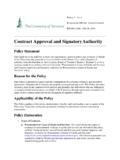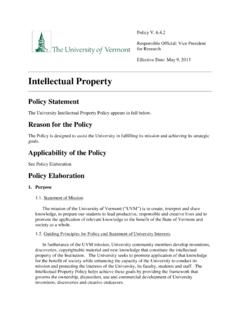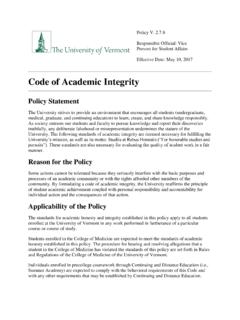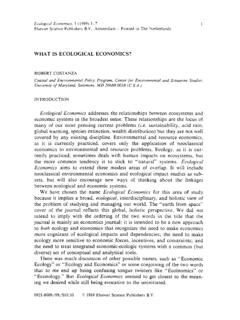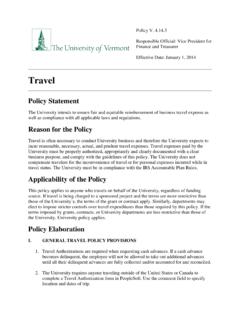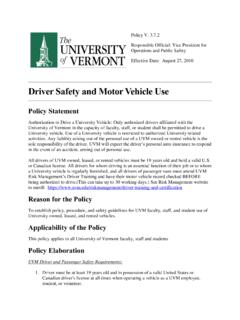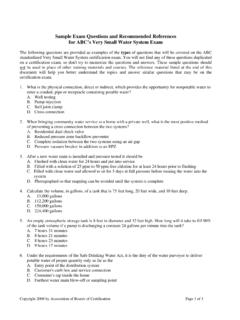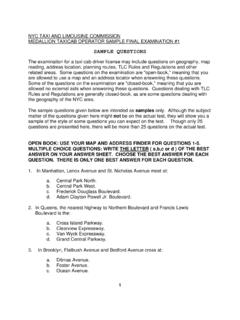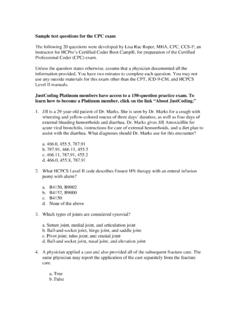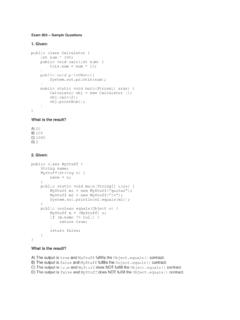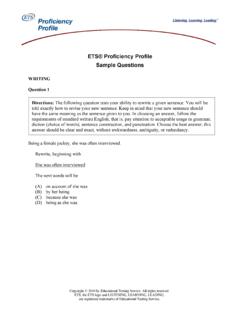Transcription of Sample exam questions: DNA, transcription, and …
1 Sample exam questions: DNA, transcription , and translation 1. The base composition of a virus was found to be 11% A, 32% G, 18% U and 39% C. It this a DNA or RNA virus? How can you tell? Is it single-stranded or double-stranded? How can you tell? 2. Which of these DNA fragments will have a higher melting temperature? (circle one) A) GCATTGACCGGAGGGACT B) GGATTTCAATTACTTAAT CGTAACTGGCCTCCCTGA CCTAAAGTTAATGAATTA 3. Here is a very short chromosome of a eukaryotic cell that lacks telomerase. Replication starts near x. One strand of the DNA has been labeled with heavy (15) N, hence the capital letters, but all newly synthesized DNA in the daughter cells will have normal N (lower case letters) 5 aaaggg .. x .. ccctttggg 3 3 TTTCCC .. X .. GGGAAACCC 5 That cell divides to make two daughter cells, which in turn divide to make four granddaughter cells. Draw these chromosome sequences as they would look in the two daughter and four granddaughter cells, keeping track of the heavy and light DNA sequences.
2 (For the purposes of this question , assume that replication uses a primer that is only 3 bases long. Also, real chromosomes would have specific sequences at the ends- I just used these because they are easy to write down.) 4. This diagram represents regions around a gene encoding a mRNA. Exon I of the mRNA contains the translation initiation AUG codon. Exon IV contains the UGA termination codon. The letters A through E above the diagram refer to areas of the gene and its transcript located directly below them. a. What region of the primary transcript is removed by a spliceosome? b. What region of the DNA contains the TATA box? c. Where is the poly (A) tail added to the transcript? d. Where is the 5' cap added to the transcript? Sample exam questions: DNA, transcription , and translation 5) A eukaryotic structural gene has two introns and three exons: 5 -exon1-intron1-exon2-intron2-exon3-3 The GU at the 5 end of intron2 has been mutated so it is no longer recognized.
3 What would the mature mRNA look like in the wild type and in the mutant? Wild type: Mutant: 6) A geneticist isolates a gene that contains five exons. She then isolates the mature mRNA produced by this gene. After making the DNA single stranded, she mixes the single-stranded DNA and RNA. Some of the single-stranded DNA hybridizes (pairs) with the complementary mRNA. Draw a picture of what the DNA-RNA hybrids would look like under and electron microscope. Keep the drawing simple ( a single line for DNA and for RNA). Hint: think about how DNA and RNA might pair and where the complementary bases are. 7) Complete the following table: Label the 5 and 3 ends of DNA and RNA and the amino and carboxyl ends of the protein. Assume it is read left to right and the columns represent transcriptional and translational alignments. (a copy of the codon table is on the last page of this exam) c DNA double helix t g a mRNA c a u tRNA anticodon g c a Amino acid trp 8) An anticodon of a tRNA has the sequence 5 GCA3.
4 A. What amino acid does this tRNA carry? Sample exam questions: DNA, transcription , and translation b. What would be the effect of a mutation that changes the C to a A? 9) One phrase is enough for these: a. How do prokaryotic ribosomes recognize the 5 end of the messenger RNA? How do eukaryotic ribosomes recognize the 5 end of the messenger RNAs? 10) The antibiotic erythromycin disrupts protein synthesis by preventing ribosomal translocation (movement of the ribosome relative to the mRNA). It does not affect any other step in protein synthesis. Suppose you are doing a translation reaction in vitro and you add erythromycin just before the 3rd bond is about to be made. You wait a few minutes and look at the ribosome. a. The carboxyl end of AA #3 should now be covalently bonded directly to (tRNA #2) (tRNA #3) (tRNA #4) (AA #2) (AA #3) (AA #4) (none of these).
5 B. Which tRNA will you find in the A site? (tRNA #1) (tRNA #2) (tRNA #3) (tRNA #4) (tRNA #5). The tRNA in the A site will carry (an amino acid) (a polypeptide) (neither) (either one). 11. Here is a short stretch of replicating DNA from the bacterium E. coli. The top strand is the template. Assume the ** are the RNA primers. This shows parts of four Okazaki fragments. 3 ---------------------------------------- ---------------------------------------- -----5 5 -----**--------------------**----------- --------**----------------*3 ^ ^ a| b| 1 2 3 4 Which was made first, the Left or the Right fragment? Which primer will be the first to be removed, Left, Middle, or Right? --continued-- Sample exam questions: DNA, transcription , and translation When the primer in the middle is removed and filled in with DNA, the fragments must then be joined.
6 Which enzyme removes the RNA primer? Which enzyme joins the fragments? Where is the final connection made? (a or b?)

